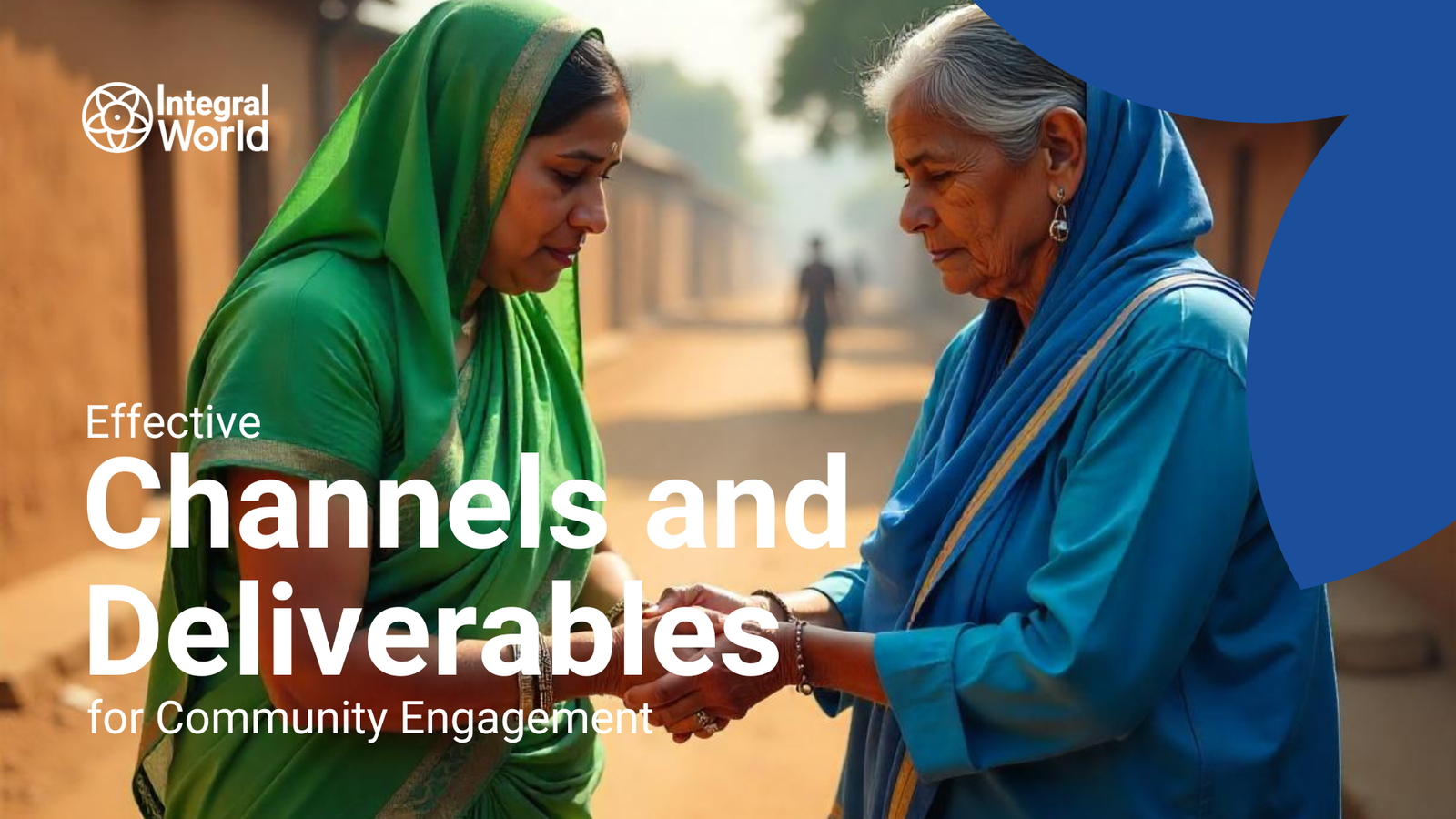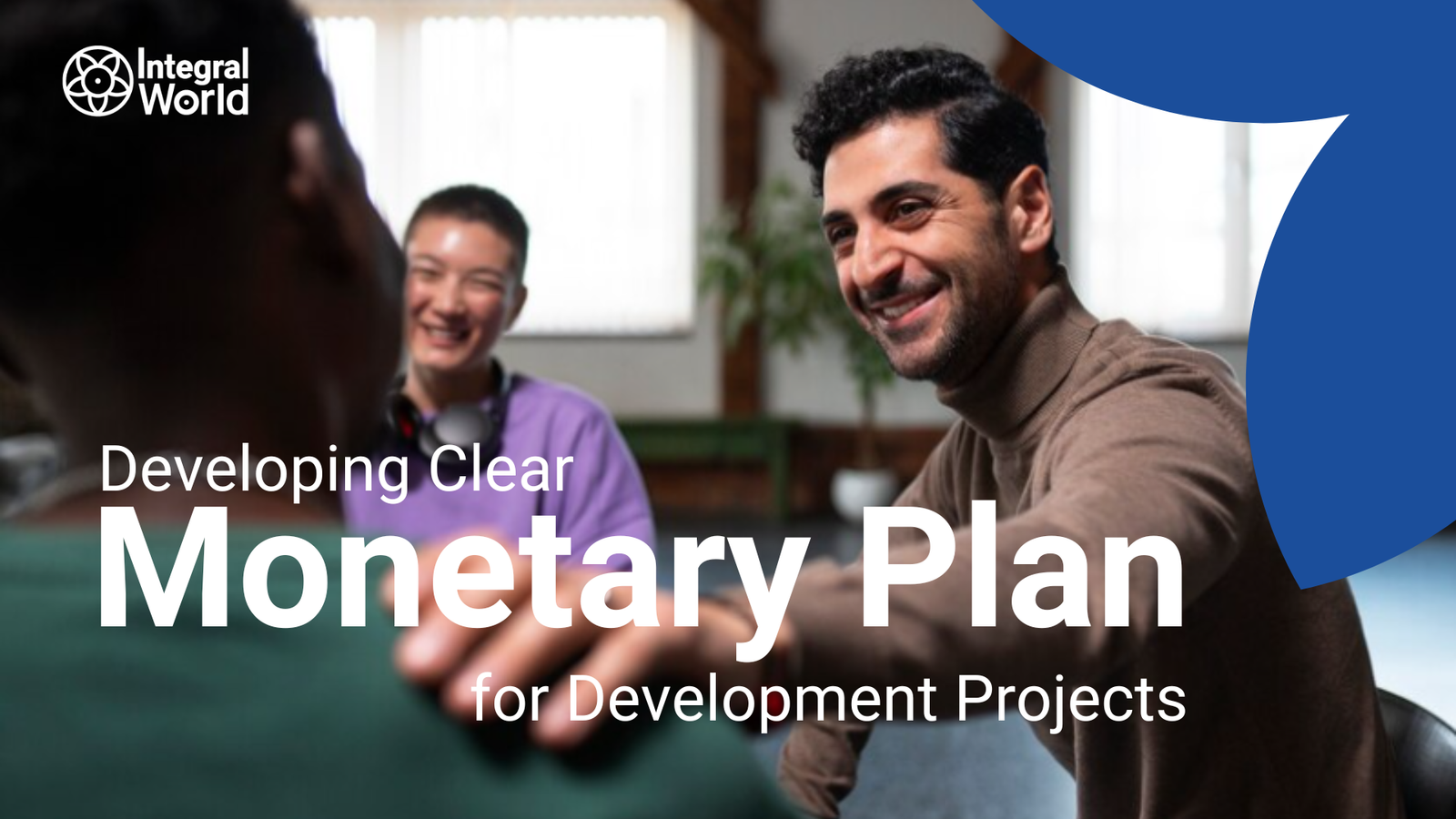Strategic positioning is essential for organizations like Integral World to drive sustainable development. Through targeted workshops and training, this NGO strengthens communities, overcomes resource challenges, and aligns activities to a clear value proposition in the competitive development sector.
Continue readingEffective Channels and Deliverables for Community Engagement
Community engagement is key to sustainability. This article guides organizations like Integral World in choosing the best channels and deliverables to build connections, boost participation, and achieve long-term goals.
Continue readingDevelop a Clear Monetary Plan for Development Projects
Our mission at Integral World is to advocate for sustainable and holistic development. This commitment includes ensuring financial viability and sustainability of all development projects we undertake. A comprehensive monetary plan should be developed as part of this effort.
This article will give step-by-step guidance with experts’ quotes and practical examples on how to develop a strong monetary plan for development projects. Also, the article will discuss the capacity of Integral World in identifying and solving developmental challenges.
Financial planning is not just another item on the list of requirements in doing what they do but rather it forms the backbone upon which the entire development undertaking stands. Without proper financial planning however even the most promising projects may fail. The success and sustainability of our initiatives at Integral World largely depends on effective monetary plans we develop.
This guide provides insights from experts using practical examples, while outlining essential steps towards developing comprehensive monetary plan.
1. Conducting Needs Assessment
Before starting with financial planning, it’s key to know what your project looks like. Hence knowing exactly what resources you need or anticipate coming across problems will emerge from conducting need surveys.
Steps for Conducting Needs Assessment:
Set Goals: Clearly state objectives for your project; what do you want to achieve? Who should benefit from this project?
Obtain Data: You can collect both qualitative and quantitative data to understand the current situation. This might involve conducting surveys, interviews, and community meetings.
Establish Resources: Identify what is needed in terms of finance including human resources as well as materials.
Identify Gaps: Notice the disparities existing between present resources and those that are required to fulfil your objectives.
Priorities Needs: Order all the significant ones from first to last importance.
Expert Quote: “A comprehensive needs assessment is the foundation of any successful project. It ensures that you’re addressing the real issues and setting realistic goals.”—Paul Farmer M.D., PhD; Co-Founder of Partners In Health

2. Setting Clear Financial Goals
Once you know what your project needs, specifically talking about your monetary plan there has to be a way of measuring this. The financial goals for your project are basically established out of its need so it is like measuring its financial success through these goals.
Steps for Setting Financial Goals:
Specify Funding Requirements: How much will it cost you to implement the whole project inclusive direct costs?
Divide Costs into Categories: Divide total funding requirement into smaller units. This may include personnel, materials, infrastructure or contingencies among others.
Set Milestones: Achievable financial milestones will help monitor progress made towards achieving funding requirements for the project.
Estimate Revenue Sources: Identify possible funds like subsidies, contributions, or partnerships.
Expert Quote: “A clear financial goal is your project’s roadmap. And this will ensure that you are focused and you have the resources needed to achieve the objectives” — Muhammad Yunus, founder of Grameen Bank
3. Creating a Detailed Budget
A detailed budget that provides an overview of all expected costs is a foundation of any sound monetary strategy and ensures appropriate allocation of money.
Steps for Creating a Detailed Budget:
List All Expenses: Identify all potential expenses related to your project. These include both direct (i.e., salaries and materials) and indirect (i.e., administrative fees) costs.
Categorize Expenses: Group up various expenses into categories for easier tracking and management.
Estimate Costs: Assign each item on your list a cost estimate by using the historical data, quotations from suppliers or opinions from experts so as to make sure it is accurate.
Allocate Funds: Figure out how much money would go into each category and item.
Review and Revise: Regularly check your own budget then adjust as required because this keeps you on track allowing reactions to changes that may arise unexpectedly.
Expert Quote: “Any project should have a well-prepared budget as it helps allocate resources efficiently while anticipating possible challenges” — Esther Duflo, Nobel laureate in Economic Sciences
4. Identifying Funding Sources
Securing funding is one of the most difficult parts of any monetary plan and a development project; hence there should be different sources of funding to guarantee financial stability in terms of funding options including venture capital funding other than relying on just one source alone.
Steps for Identifying Funding Sources:
Research Grant Opportunities: The search for grants from government agencies, international organizations, and private foundations which are aligned with your project goals should begin here first.
Engage Donors: Create personal contacts with individual donors who are passionate about what you are doing making it more personalized and more convincing.
Partner with Corporations: Approach corporations with corporate social responsibility (CSR) programs to form partnerships that can provide support in terms of money as well as in-kind donations.
Crowdfunding: Use crowdfunding platforms which help you reach a wide audience and collect small sums from each.
Fundraising Events: Organize events that will raise funds and engage your community. They also act as an avenue for creating awareness about the project and getting new supporters.
Expert Quote: “To avoid overdependence on one source of finance, every project should diversify its financial sources so as to have a steady flow of resources” — Melinda Gates, co-chair of the Bill & Melinda Gates Foundation

5. Implementing Financial Management Practices
Efficient financial management practices help ensure control over project finances, transparency and accountability.
Steps for Implementing Financial Management Practices:
Establish Financial Policies: Create policies and procedures governing financial management in your project including those relating to budgeting, expenditure control as well as reporting.
Use Accounting Software: Install accounting software packages capable of tracking income and expenses, managing budgets, or generating financial statements.
Monitor Cash Flow: Watch your cash flow regularly to make sure it is enough to meet all charges. Address any cash-flow challenges promptly when they arise.
Conduct Audits: Conduct regular internal audits together with external audits so as to be accurate on issues regarding finance and regulations compliance at all times.
Report to Stakeholders: Release periodic financial reports for donors, partners or other members of the public. By practicing transparency we develop trust encouraging people’s ongoing support.
Expert Quote: “A project cannot succeed without efficient financial management which is crucial in ensuring that resources are utilized properly and stakeholders have faith in your organization.” — Ngozi Okonjo-Iweala, Director-General, World Trade Organization
6. Monitoring and Evaluation
The continuous monitoring and evaluation of the financial health of your project assists you to make informed decisions.
Steps for Monitoring and Evaluation:
Set Performance Indicators: Put forth some key performance indicators (KPIs) to measure the success of your project within a financial context. These can include budget compliance, cost avoidance, as well as fundraising efficiency.
Track Expenses: Always keep track of how much you spend against what you had planned to spend. This will enable you to identify any variances and their causes.
Evaluate Revenue Streams: Evaluate how well funding sources perform. Find out those that are doing well and those that need improvement.
Adjust Plans as Needed: Make adjustments to your financial plan using information obtained from monitoring and evaluation activities. This might require you either source new finances or even reallocate money or just revise goals related to projects.
Report Findings: Share these findings with stakeholders so they can be aware. By being transparent about this it will promote trust between parties involved by looking responsible on matters related to finance.
Expert Quote: “Diversifying your funding sources is crucial for sustainability. It reduces dependence on a single source and ensures a steady flow of resources.” — Melinda Gates, co-chair of the Bill & Melinda Gates Foundation

Actionable Tips:
Begin Early: Start your financial planning process as soon as possible so that you are able to secure funding in time and allocate resources appropriately.
Let there be transparency: In your financial transactions let there be openness so that stakeholders will have confidence in you which leads to continued support
Stay flexible enough: Be ready to make any changes in your financial plan based on findings of monitoring and evaluation
Involve stakeholders all along the way: Keep stakeholders informed and engaged throughout the financial planning process so that they feel part of it.
Embrace Technology: Use technology in order to simplify things such as finance management while ensuring accuracy and efficiency at all times.
Conclusion
Developing comprehensive monetary plan is crucial for successful development projects. These include carrying out needs assessment, setting up clear targets for money, preparing a budget with details, identifying many sources of funds, using efficient means of managing finance, routinely monitoring performance towards set goals among others. This way non-profit organizations can ensure their projects do not drain financially but rather stay financially viable through implementing them within provided budgets.
At Integral World we take pride in our ability to develop robust monetary plans. Our method has led us through countless developmental hurdles while achieving sustainable positive outcomes for our served communities. Integral World is committed to fostering sustainable holistic development. In accomplishing these aims please partner with us by supporting our initiatives or getting involved otherwise. For additional information about this organization including its projects log on www.integralworld.org . By joining hands together we can form an even brighter future than this one.
“Service to others is the rent you pay for your room here on earth.” – Muhammad Ali
Crafting Vision & Mission Statements for Development Orgs.
Development organizations need to develop clear vision and mission statements that are persuasive. They guide the organization’s actions, and decisions and also communicate its purpose and direction to stakeholders.
Integral World is a non-profit organization whose commitment is to have a positive, meaningful, and sustainable impact on the world. It operates in the development sector through a comprehensive understanding of storylines; deepening insight into issues; and offering solutions for enduring change.
This article will discuss the importance of having vision and mission statements for developmental organizations, as well as show you how to come up with them step by step.
The Importance of Vision and Mission Statements
Vision Statement
A vision statement sets out an organization’s long-term goals or the ultimate impacts it intends to make. It offers guidance towards strategic planning. A well-written vision statement ensures the alignment of efforts among employees while motivating them towards achieving a common goal.
Example – Oxfam’s vision : A world without poverty
Mission Statement
A mission statement details the primary objectives or core purpose within which an organisation operates. What does this firm do? Who are its clients? How does it do that? It acts as a basis for decision-making ensuring everything done ties back to why it was started.
Example – World Food Programme mission : To end hunger in our lifetime by providing food and life-changing aid to the world’s most vulnerable.
Crafting Vision and Mission Statements
Step 1: Define Your Core Values
Core values are principles that guide people in making organisational decisions. These values shape what matters most to an organisation thus becoming part of its culture. Core values form the bedrock upon which both the mission & vision statements are built.
Example Values:
Integrity, Accountability, Innovation, Compassion, Sustainability
Step 2: Identify Your Long-Term Goals
Long-term goals are the broad objectives that organisations strive to attain. These goals should be challenging but within reach and consistent with an organisation’s core values. Identifying long term goals helps in shaping vision statements as they should reflect aspirations of an organisation.
Example Long-Term Goals:
- Eradicate extreme poverty and hunger
- Ensure universal access to education
- Promote gender equality and empower women
- Combat climate change and its impacts.
Step 3: Understand Your Audience
Understanding your audience requirements is critical in coming up with a vision and mission statement that resonates with them. The stakeholders may include donors, beneficiaries, partners, employees, and the general public. Listening to stakeholders and getting their feedback will not only help in developing relevant vision/mission statements but also one that appeals to them.
Step 4: Draft a Vision Statement
The vision statement should be concise, clear and inspiring. This means that it must be able to give an overview of what the organisation wants to achieve in the long run while showing its core values. When developing the vision statement, there are some tips that one may consider as shown below:
- Use plain language
- Think about the end game
- Make it aspirational and inspirational.
For example – Water.org : A world where everyone has access to clean water.
Step 5: Drafting Your Mission Statement
Mission statements must provide a clear, brief description of an organisation’s purpose and objectives. For instance, they define what an organisation does, who it serves and how its aims are achieved. There are certain factors people must think about when creating a mission statement given below:
- Be Specific and Clear
- Put attention on the central objective of the organisation.
- Focusing on key activities and beneficiaries.
For instance, To provide safe and sustainable drinking water to communities in need through innovative and community-driven solutions. – Water.org
Step 6: Review & Refine them
After writing vision and mission statements; share these with relevant parties for feedback gathering which is critical towards ensuring clarity, relevance as well as inspiration of these statements. Based on this feedback received, refine these statements aligning them with organisational core values/long term strategic goals.
Step 7: Communicate & Implement them
On finalising with vision & mission statements communicate to all members of the organisation besides embedding them into strategic planning processes as well as decision making process. Therefore such wordings should be conspicuously placed on the website of any given organisations promotional materials plus their internal documents. So regularly review these statements, updating them accordingly if any goal/value changes occur within such a firm.
Improving Organisational Effectiveness
Matching Activities with Aim
A clear vision and mission steers all programs towards an organisational purpose. Therefore such unison makes sure that the best use is made of resources hence an effective organisation.
Engaging and Motivating Stakeholders
Vision and mission statements are inspirations to stakeholders. They act as a communication channel to attract donors, partners, and employees in order for them to understand the purpose behind it all. To this end, it’s important to establish viable long-term relationships with these entities.
Guiding Strategic Planning
These statements lay down the foundation of strategic planning and decision making. In addition, they grant assistance when it comes to setting priorities along with allocating resources towards achievement of organisational goals thus helps in measuring progress. Thus with such guidance, one can have a business which is always focused on its core reason for existence as well as future impact desired.
Developing Organisational Culture
A clear vision and mission statement furthermore helps in building a strong organisational culture that aligns with the core values of an organisation. Such culture enhances team members’ commitment towards objectives by providing a sense of direction they need to work together as a group.
Conclusion
If development organisations are to be successful in their missions, they must develop clear and compelling vision and mission statements. Such statements guide an organisation’s acts and decisions and communicate its ends to stakeholders. Following the steps outlined in this article, organisations can come up with mission and vision statements that inspire, involve and direct their actions towards bringing about a positive impact on the world.
For more information on how we can assist your organization to articulate its principles for sustainable change, please get in touch with us on reach@integralworld.org.
We invite you to participate in our initiatives as part of the worldwide campaign on integrated development for social equity.
“Our prime purpose in this life is to help others. And if you can’t help them, at least don’t hurt them.” – Dalai Lama




